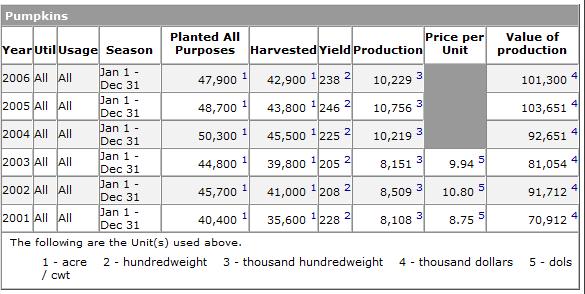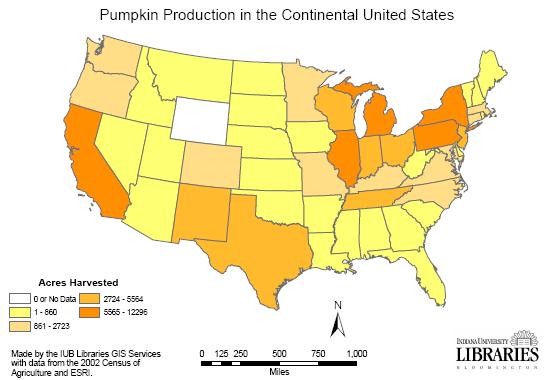
Pumpkin Production: Facts, Trends and Resources
Pumpkin Crop Productions: Trends, Facts and Resources for the Journalists and Farmers
This page provides a single source compilation of various reports, graphs and data about pumpkin production to assist the mass media (journalist, magazine and newspaper writers, tv/radio reports) and farmers who may be considering growing pumpkins commercially in analysis. If your looking for Halloween information, see this page of current Halloween facts and statistics)
2002 Distribution of
Pumpkin Production
in the Continental United States
The map below shows the 2002 distribution of pumpkin production in the
U.S. Note the concentration in the Great Lakes states, California and
Texas. The Mid-Atlantic follows closely.In 2005, Illinois was number one among the top five
pumpkin producing states, with almost 4.97 million pounds, followed by
California with almost 1.6 million pounds, Ohio with 1.33 million
pounds, Pennsylvania with 1.31 million pounds and Michigan with 854
thousand pounds.
The top five states for value of pumpkin production in 2005 were Ohio
with $26.1 million, New York at $21.9 million, Pennsylvania at $16.2
million, Illinois with slightly over $16 million and California with
nearly $14.4 million
The next graph shows the total U.S. pumpkin crop production annually for years 2001 through 2006. The source of this data is the US Department of Agriculture. ("Crops and Plants"->"Fruits"->"Pumpkins"->Search). This graph shows that production was steady until 2004 when it increased by 20% and has held steady since then.

Every year since 2004 there have been regional difficulties. A frost, drought, flooding rains, pests or even deer damaging crops. Areas affected by Katrina (August 25, 2005) reduce that year's crop. Katrina wiped them out and many farms left the business not to return. 2007 heavy rains in the Midwest and Texas affected those crops.
Availability of Pumpkins and Opportunity for Growers
As the large chain stores put more of the national crop under contract, there is much less available in bulk or wholesale for smaller operations; such as local festivals and pumpkin fundraisers. Many churches and community organizations use pumpkin patches and Christmas tree sales to help raise money for their organizations. If they are forced to buy their pumpkins at retail prices, it dramatically reduces their income. This creates an opportunity for more farmers to get into the business. Add to this the popularity of Halloween (it is actually a global phenomenon: it's become very popular in Japan and France, for example), which has raised the overall demand for pumpkins against a reduced supply.
Pumpkins do have the advantage of tolerating most soil types and many climates. They just don't do well is very sandy soils, under water or when pests (such as borers) are prevalent. They also require a long growing season, and cannot tolerate any frost. This makes them a bit less advantageous as a succession crop, except preceding a winter green cover crop and following a Spring (June-bearing) strawberry crop (or similar). Many pick-your-own farms plant strawberries (notably "Chandler") in the Fall, open a pyo strawberry field in April to June, then plow the strawberries under to plant pumpkins for an October crop and pumpkin patch.
Commercial Pumpkin Growing Techniques
Squashes prefer a well-drained sandy loam with high organic matter and a pH of 6.0 to 6.5. The Cooperative Extension Service or a soil-testing laboratory can provide nutrient recommendations based on soil tests. Conventional production recommendations (when soil-test results are not available) are to apply 50 pounds N, 100 pounds P2O5, and 100 pounds K2O per acre before planting, with two additional applications of 25 pounds N and 80 pounds K per acre at 3 and 6 weeks. Should you wish to convert these standard recommendations to organic fertilizer rates, visit the site from the University of Georgia Circular 853 How to Convert an Inorganic Fertilizer Recommendation to an Organic One. That is a useful point as more consumers are willing to pay for organic crops, although, since large decorative pumpkins are rarely eaten, the value of the organic proposition would be greatest in the edible varieties and for those farmers opening their fields for direct consumer pick-your-own pumpkin patch sales.
Pumpkins are warm-season annuals, preferring 75° to 86° F daytime and 64° F nighttime temperatures. The seeds germinate most rapidly when the soil temperature is 86° F. Winter squash and pumpkins can be direct-seeded as soon as the soil temperature reaches 60° F. They need 90 to 120 frost-free days to reach maturity. Plastic mulches of various colors can be used to increase the soil temperature and speed early-season plant growth.
The worst pests are squash bugs, cucumber beetles and squash vine borers. Of these, the worst is the borer: a fat, 1-inch-long, brown-headed white caterpillar, the larva of a ¾-inch-long moth with dark front wings, clear hind wings, and a red abdomen. The moths lay single eggs in late spring or early summer along the stem near the base of a vine. The larvae emerge in about a week and bore holes to enter the stem. Evidence of borer activity are the small hole and a pile of tan or greenish sawdust (excrement) beneath the hole. The vine wilts suddenly and dies.
For some organic solutions to these pests, see:
Other Pumpkin Growing Resources:
Books:
Free Guide from Penn State: Agricultural Production of Pumpkins
Varieties of Pumpkins
- Sugar - Excellent for baking
- JackO'Lantern - most common for carving
- WhiteLumina - unusual, medium-sized white pumpkin
- Mini- Great for decoration
- Gourds - Many varieties, used for decorations
Want to Grow Your Own Pumpkins?
Halloween Costumes
Here are some of the most popular Halloween costumes for children this year. For more choices, see our Halloween costumes pages.
- Inflatable Riding Dinosaur Costume for Adults - everyone LOVES this costume. It's a hit where ever you go!
- Harry Potter Costume Kids Plush Robe - With a hood, one for each house, Gryffindor, Hufflepuff, Slytherin, Ravenclaw, Hogwarts
- Wizard Robe Cloak Halloween costume for Kids
- Girl's Sparkle Princess Costume - In pink, for small girls
- Sew your own Halloween Costumes with Patterns from the Singer Sewing Reference Library
- Pizza Costume for Kids - A giant slice of pizza Halloween Costume for Children and Teens
- Easy Halloween Costumes for Children - Miniature patterns for 3 to 12 year old children, just enlarge and use
Find Related Information and Resources Here!
Here's the quick list to related farms for PYO, Honey, Pumpkins, Christmas trees, etc.:
You may find these websites useful!
- Local pick your own farms for apples, strawberries, raspberries, corn, tomatoes, etcr
- Farm markets and roadside stands
- Local Honey Finder
- Children's consignment sales
- Local Meat, Milk and Eggs
- Christmas Tree Farms and lots
- Road tripping and camping tips, tricks and How-to's
- Fun Factory Tours
- Venues for you event: Farms, Wineries, Orchards for your event, wedding or party
- Easter egg hunts
- Festivals: Fruit and vegetable festivals
- Winery tours and wine tastings
- Horses: rides, stables, lessons, trails
- Maple Syrup farms and sugarworks
- Bed and Breakfasts on Farms, Wineries, Ranches and Orchards
- Zombie Paintball venues
- Environmental resources
- Consumer fraud information
- Wholesale food sources
- Resources for Farmers
- Pumpkin patches
- Corn mazes
Water bath canning kit - 8 Piece Enamelware Pot with Canning kit and Rack. Canning Supplies Starter Kit
Double Donut Pumpkin Spice Coffee Pods, Single Serve Flavored Coffee for Keurig K Cups Machines,
Pumpkin Spice - Organic, 1.94-Ounce Jar, Nutmeg, Cloves, Ginger & Cinnamon, Enhances Tea, Seasoning, Kosher
Maud's Pumpkin Spice Instant Latte - 16 count Packets, Love Me Some Pumpkin Spice Latte
Pumpkin Pie Spice Blend Extract,McCormick Pure
Don't miss our page of costumes, ready made and ones you can make yourself!
And here's a book of 130 pumpkin carving stencils!
Pumpkin Carving stencils book - Over 130 Halloween jack olantern pumpkin designs. Including Witches, Cats, skulls, bats, ghosts, and so much more
More carving kits and stencils are here!
Find Other types of farms:
- Pick Your Own apples
- Christmas Tree Farms and lots
- Farm markets and roadside stands
- Local Honey
- Local Meat, Milk and Eggs
- Road trip and camping
Get the
most recent version of
the Ball Blue Book
Click here to get Halloween Costumes delivered - fast, great prices!
Click here to get Halloween Costumes delivered - fast, great prices!
Find Other types of farms:
- Pick Your Own apples
- Christmas Tree Farms and lots
- Farm markets and roadside stands
- Local Honey
- Local Meat, Milk and Eggs
- Road trip and camping
Get the
most recent version of
the Ball Blue Book
